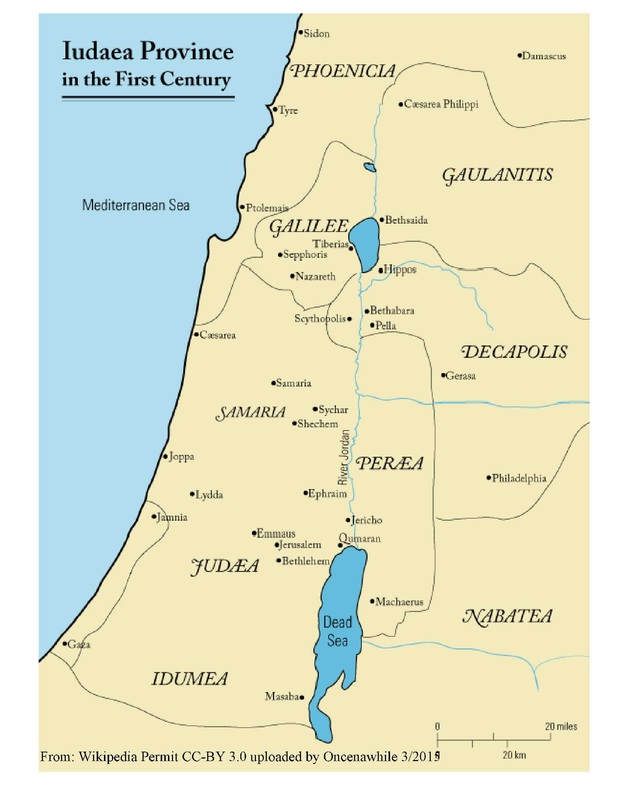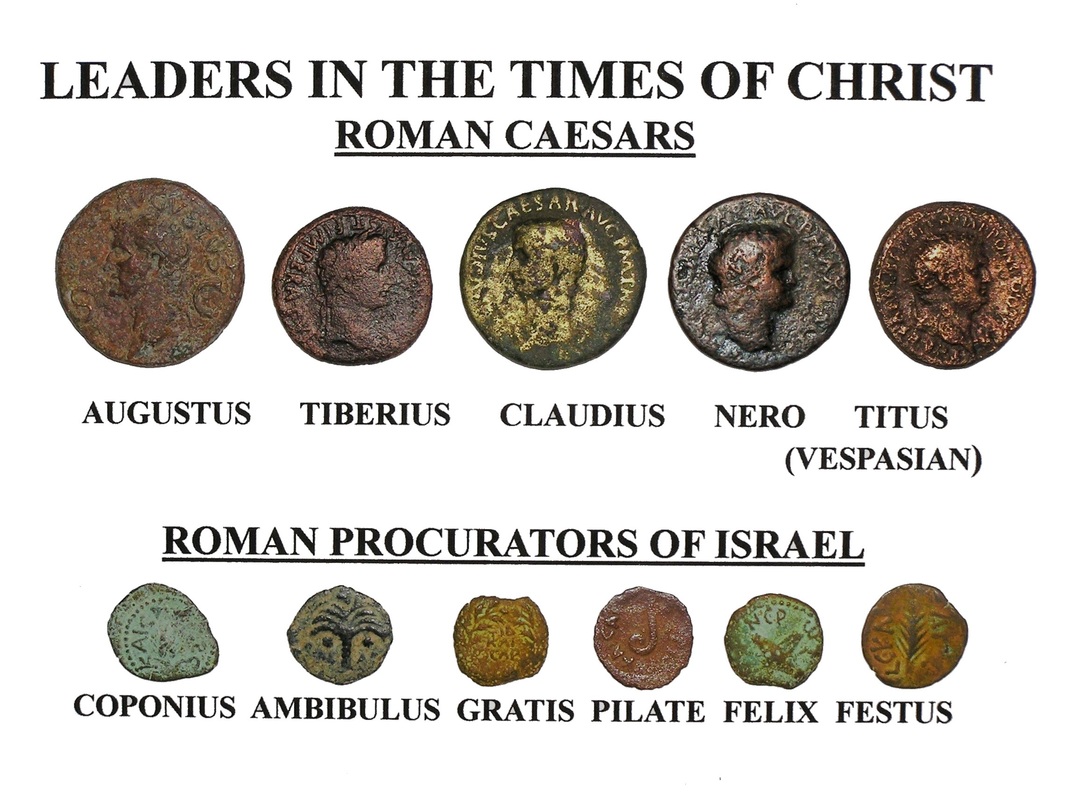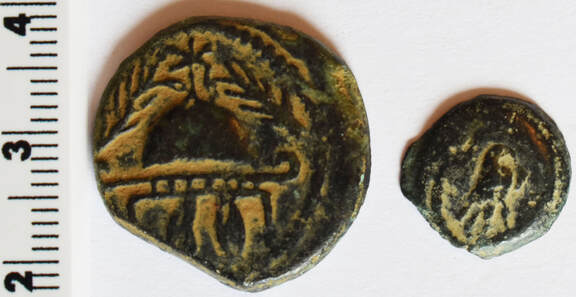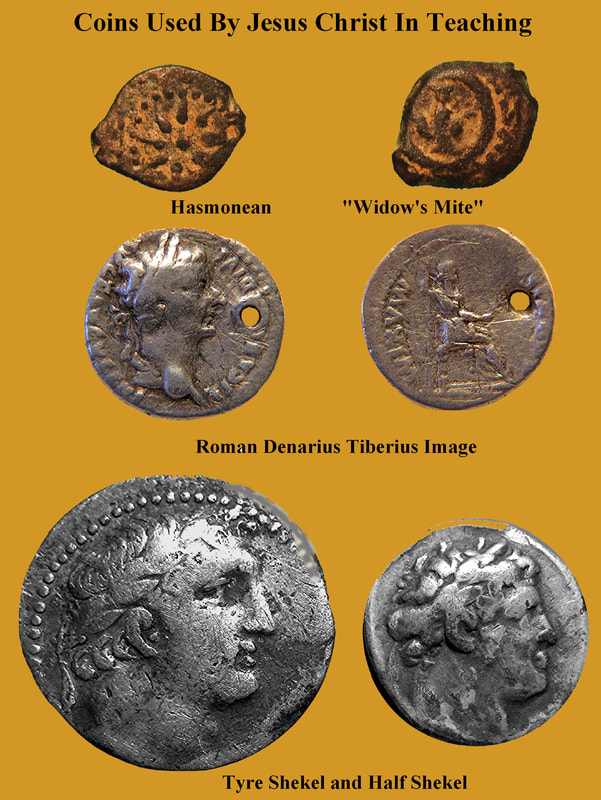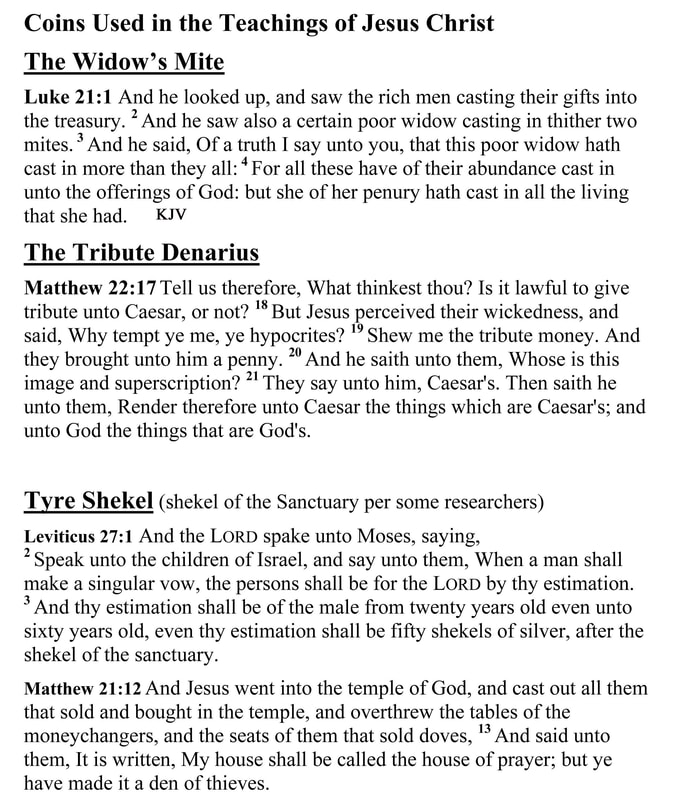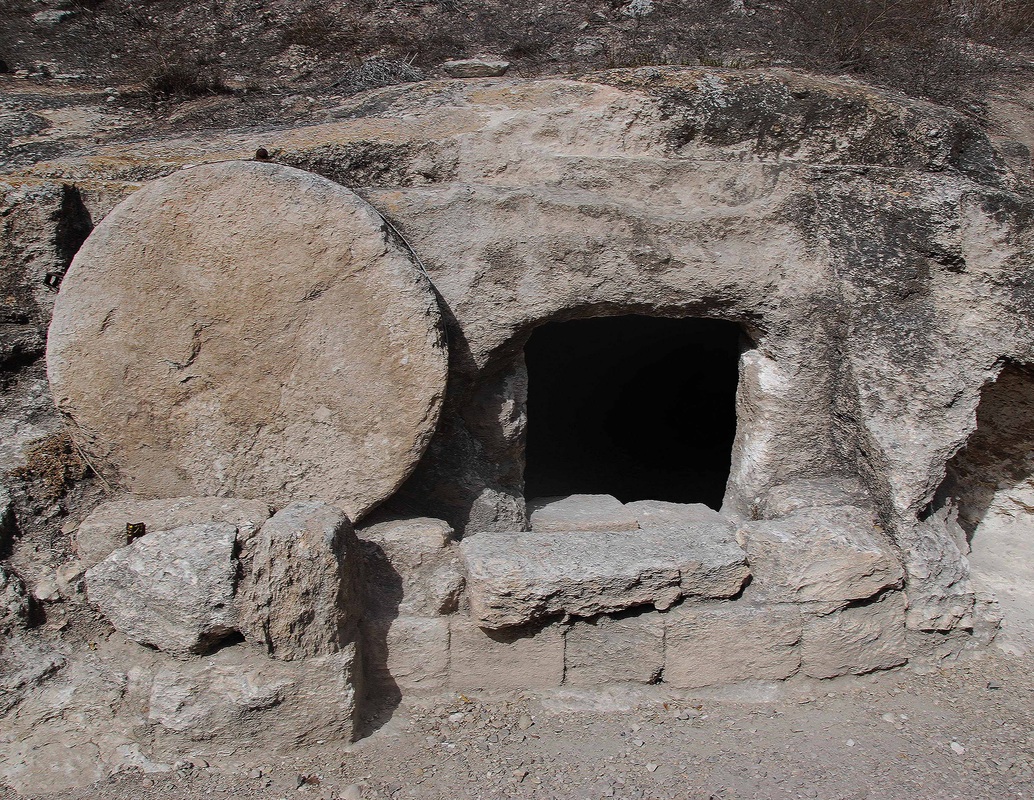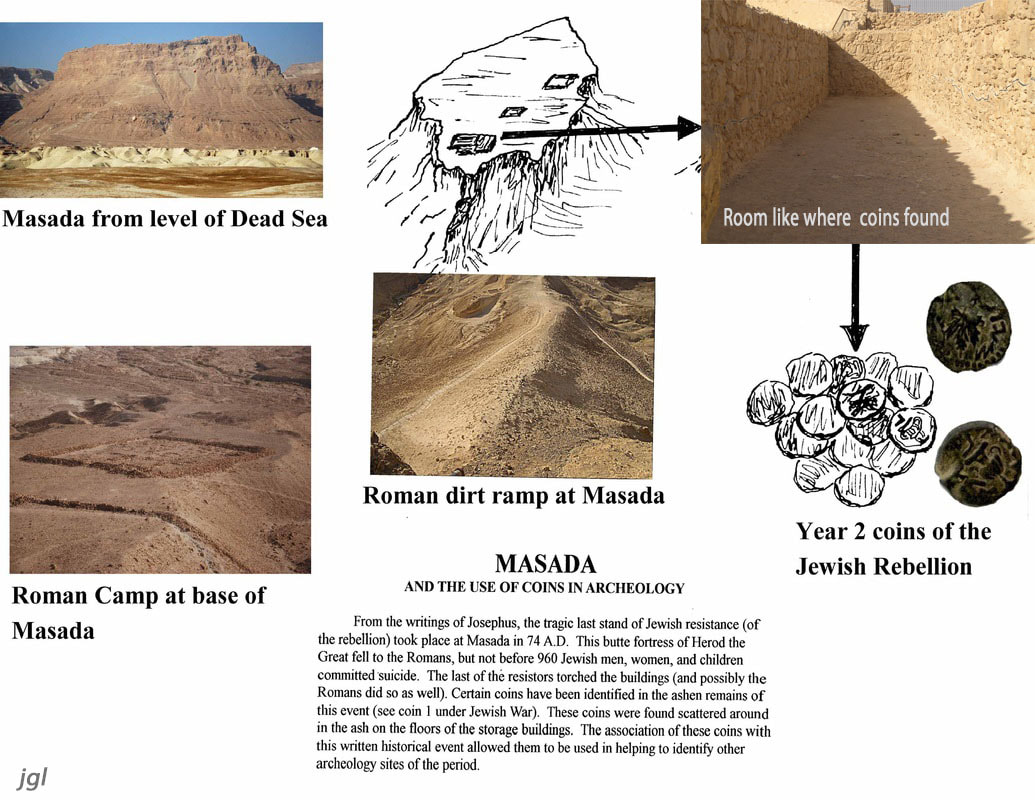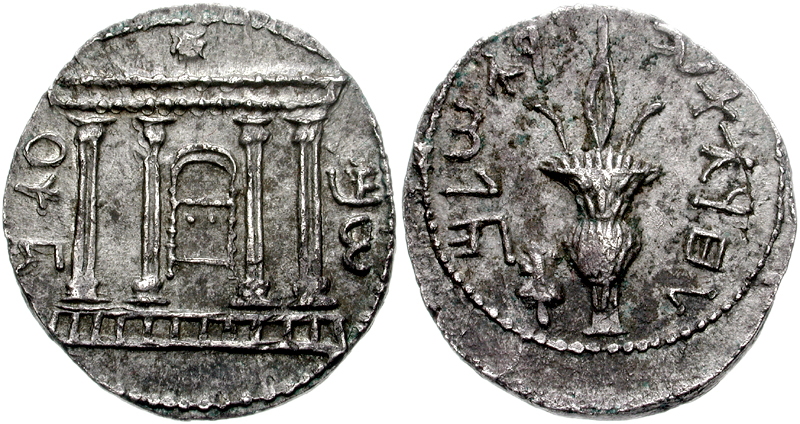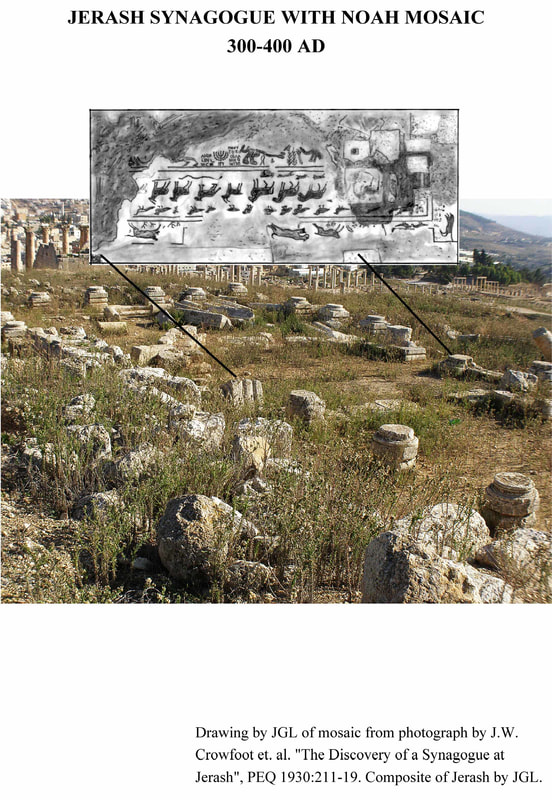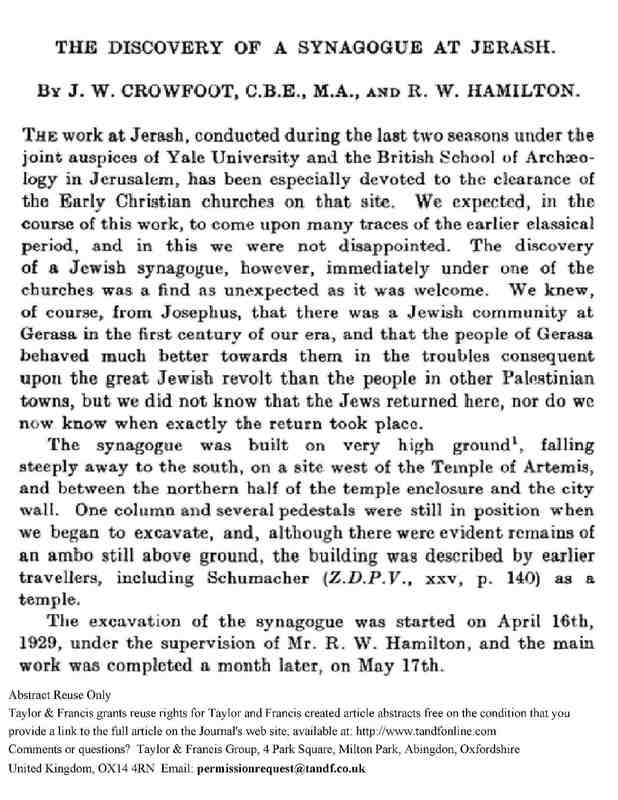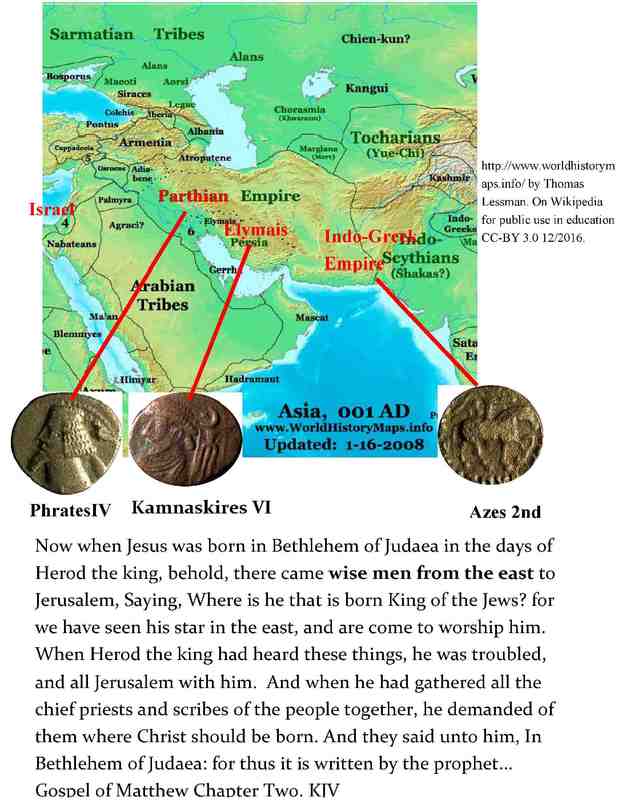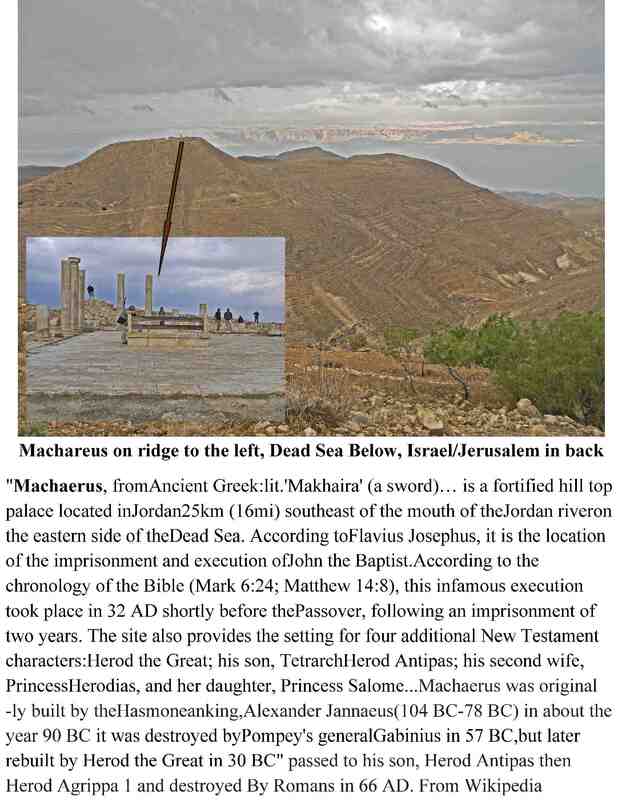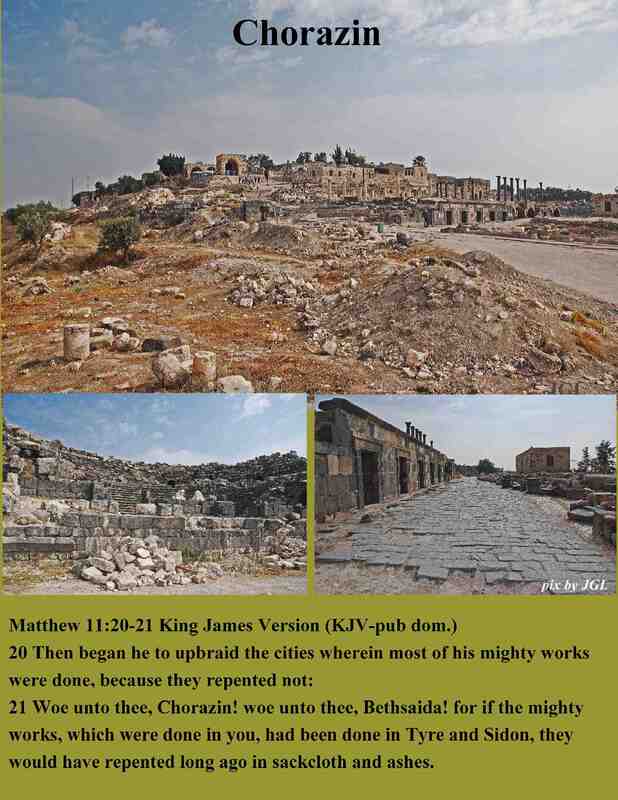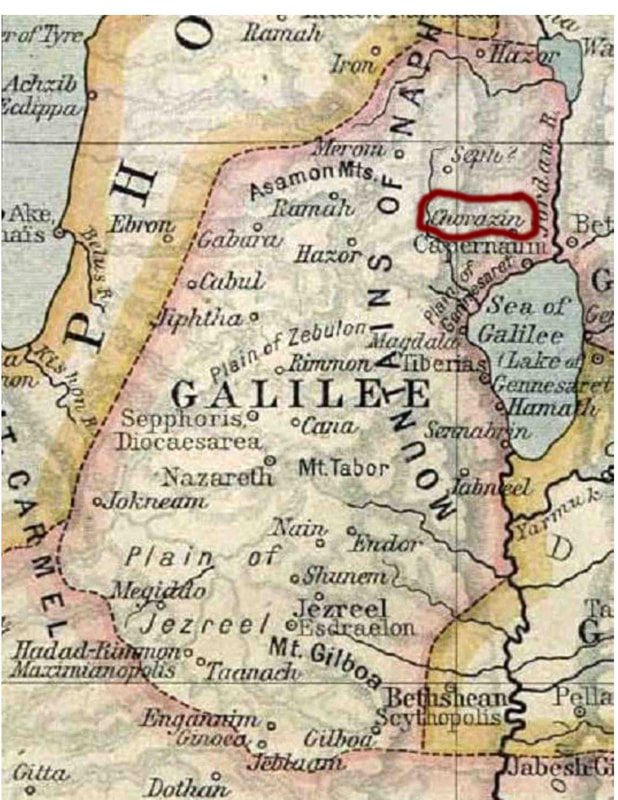New Testament Related Artifacts and Places
A Summary of Roman History in the Times of Christ Revealed in Coins of the Times and the Biblical Scriptures
Herod 1st: Ruler in Jerusalem During the Birth of Jesus Christ
Scale cm 8 Prutah Lepton
"However, a prutah of Herod was the first coin since the Persian period to depict a living creature - an eagle, which may have been an allusion to the golden eagle that Herod erected over the entrance to the Second Temple, and which caused such great offence to the Jews." (From Wikipedia) It appears to be a lepton to me-jgl.
"However, a prutah of Herod was the first coin since the Persian period to depict a living creature - an eagle, which may have been an allusion to the golden eagle that Herod erected over the entrance to the Second Temple, and which caused such great offence to the Jews." (From Wikipedia) It appears to be a lepton to me-jgl.
Per D Hendin, coin specialist*, Herod 1st was a very insecure man and felt he had many potential threats to his rulership in Jerusalem. So he put to death those who concerned him, even his Hasmonean wife Mariamne and his sons by her in 29 BC. He also killed many of the Sanhedrin after his gaining control as king. As well, he was the one who killed all the infants in Bethlehem after the birth of Jesus Christ the Messiah:
Matthew 2
11 “And when they were come into the house, they saw the young child with Mary his mother, and fell down, and worshipped him: and when they had opened their treasures, they presented unto him gifts; gold, and frankincense and myrrh.
12 And being warned of God in a dream that they should not return to Herod, they departed into their own country another way.
13 And when they were departed, behold, the angel of the Lord appeareth to Joseph in a dream, saying, Arise, and take the young child and his mother, and flee into Egypt, and be thou there until I bring thee word: for Herod will seek the young child to destroy him.
14 When he arose, he took the young child and his mother by night, and departed into Egypt:
15 And was there until the death of Herod: that it might be fulfilled which was spoken of the Lord by the prophet, saying, Out of Egypt have I called my son.
16 Then Herod, when he saw that he was mocked of the wise men, was exceeding wroth, and sent forth, and slew all the children that were in Bethlehem, and in all the coasts thereof, from two years old and under, according to the time which he had diligently inquired of the wise men.
17 Then was fulfilled that which was spoken by Jeremiah the prophet, saying,
18 In Rama was there a voice heard, lamentation, and weeping, and great mourning, Rachel weeping for her children, and would not be comforted, because they are not.”
Herod 1st was appointed to his position by the Roman Senate and was a friend of Augustus the Emperor. He rebuilt the Temple to mollify the Jewish People. Yet, it appears that he placed the symbol of a golden eagle on the temple and created a coin with the graven image on it. See the lepton on the right side of the image. Eagle was on the reverse and lettering stating King Herod with cornucopia on the obverse. This would have been offensive to the Jewish People.
The large coin on the left side of the image is an 8 prutah. It has a helmet on the reverse side. The obverse side has a tripod with ceremonial bowl and Greek lettering stating year 3 of King Herod.
See David Hendin’s book Guide to Biblical Coins 2001-section on Herodian Coins.
Matthew 2
11 “And when they were come into the house, they saw the young child with Mary his mother, and fell down, and worshipped him: and when they had opened their treasures, they presented unto him gifts; gold, and frankincense and myrrh.
12 And being warned of God in a dream that they should not return to Herod, they departed into their own country another way.
13 And when they were departed, behold, the angel of the Lord appeareth to Joseph in a dream, saying, Arise, and take the young child and his mother, and flee into Egypt, and be thou there until I bring thee word: for Herod will seek the young child to destroy him.
14 When he arose, he took the young child and his mother by night, and departed into Egypt:
15 And was there until the death of Herod: that it might be fulfilled which was spoken of the Lord by the prophet, saying, Out of Egypt have I called my son.
16 Then Herod, when he saw that he was mocked of the wise men, was exceeding wroth, and sent forth, and slew all the children that were in Bethlehem, and in all the coasts thereof, from two years old and under, according to the time which he had diligently inquired of the wise men.
17 Then was fulfilled that which was spoken by Jeremiah the prophet, saying,
18 In Rama was there a voice heard, lamentation, and weeping, and great mourning, Rachel weeping for her children, and would not be comforted, because they are not.”
Herod 1st was appointed to his position by the Roman Senate and was a friend of Augustus the Emperor. He rebuilt the Temple to mollify the Jewish People. Yet, it appears that he placed the symbol of a golden eagle on the temple and created a coin with the graven image on it. See the lepton on the right side of the image. Eagle was on the reverse and lettering stating King Herod with cornucopia on the obverse. This would have been offensive to the Jewish People.
The large coin on the left side of the image is an 8 prutah. It has a helmet on the reverse side. The obverse side has a tripod with ceremonial bowl and Greek lettering stating year 3 of King Herod.
See David Hendin’s book Guide to Biblical Coins 2001-section on Herodian Coins.
Jesus Christ and the Use of Coins
Go to bookstore for information on a book that goes into more detail.
Rock Hewn Tomb from the first Century A.D. in Israel
(Matthew 28:1-3 Now after the Sabbath, as it began to dawn toward the first day of the week, Mary Magdalene and the other Mary came to look at the grave. And behold, a severe earthquake had occurred, for an angel of the Lord descended from heaven and came and rolled away the stone and sat on upon it. And his appearance was like lightening, and his garment as white as snow;...")
Where Jesus Walked- 1st Century A.D. in Israel
Bethsaida (Where Jesus heals the blind man)
Mark 8:21-23 And he said unto them, How is it that ye do not understand?
22 And he cometh to Bethsaida; and they bring a blind man unto him, and besought him to touch him.
23 And he took the blind man by the hand, and led him out of the town; and when he had spit on his eyes, and put his hands upon him, he asked him if he saw ought. 24 And he looked up, and said, I see men as trees, walking.25 After that he put his hands again upon his eyes, and made him look up: and he was restored, and saw every man clearly.
Capernaeum (Where Jesus heals a man of "palsy")
Matthew 8;5-10 "And when Jesus was entered into Capernaum, there came unto him a centurion, beseeching him,6 And saying, Lord, my servant lieth at home sick of the palsy, grievously tormented.
7 And Jesus saith unto him, I will come and heal him.8 The centurion answered and said, Lord, I am not worthy that thou shouldest come under my roof: but speak the word only, and my servant shall be healed.9 For I am a man under authority, having soldiers under me: and I say to this man, Go, and he goeth; and to another, Come, and he cometh; and to my servant, Do this, and he doeth it.10 When Jesus heard it, he marvelled, and said to them that followed, Verily I say unto you, I have not found so great faith, no, not in Israel." KJV online.
Mark 8:21-23 And he said unto them, How is it that ye do not understand?
22 And he cometh to Bethsaida; and they bring a blind man unto him, and besought him to touch him.
23 And he took the blind man by the hand, and led him out of the town; and when he had spit on his eyes, and put his hands upon him, he asked him if he saw ought. 24 And he looked up, and said, I see men as trees, walking.25 After that he put his hands again upon his eyes, and made him look up: and he was restored, and saw every man clearly.
Capernaeum (Where Jesus heals a man of "palsy")
Matthew 8;5-10 "And when Jesus was entered into Capernaum, there came unto him a centurion, beseeching him,6 And saying, Lord, my servant lieth at home sick of the palsy, grievously tormented.
7 And Jesus saith unto him, I will come and heal him.8 The centurion answered and said, Lord, I am not worthy that thou shouldest come under my roof: but speak the word only, and my servant shall be healed.9 For I am a man under authority, having soldiers under me: and I say to this man, Go, and he goeth; and to another, Come, and he cometh; and to my servant, Do this, and he doeth it.10 When Jesus heard it, he marvelled, and said to them that followed, Verily I say unto you, I have not found so great faith, no, not in Israel." KJV online.
Arch of Titus Which Celebrated Rome's Assault of the Jewish Nation in Jerusalem 70 A.D. (Arch was built in 82 A.D.)
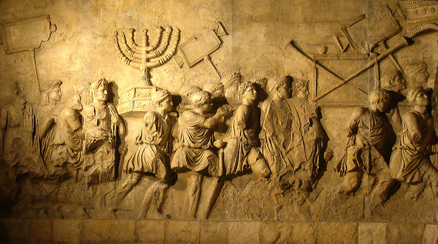
The arch is situated on a prominent rise, the Velian Hill, which is a low saddle between the Palatine and Esquiline Hills, just south-east of the Roman Forum. The arch itself is 13.50 metres wide, 15.40 high, and 4.75 deep while the inner archway is 8.30 metres high and 5.36 wide. Constructed in 82 AD by Domitian in honor of his brother Titus.
The south panel depicts the spoils taken from the Temple in Jerusalem. The Golden Candelabra or Menorah is the main focus and is carved in deep relief. Other sacred objects being carried in the triumphal procession are the Gold Trumpets and the Table of Shew bread.[2] These spoils were originally gilded with gold, with the background in blue.[2] From Wikipedia. Photograph from Wikipedia with permit-Steerpike CC BY 3.0.
This was a fulfillment of what Jesus spoke of in Matthew 24:1-2; 1"And Jesus went out, and departed from the temple: and his disciples came to him for to shew him the buildings of the temple. 2 And Jesus said unto them, See ye not all these things? verily I say unto you, There shall not be left here one stone upon another, that shall not be thrown down."
See Tab Biblical Archaeology for information on Jerusalem.
The south panel depicts the spoils taken from the Temple in Jerusalem. The Golden Candelabra or Menorah is the main focus and is carved in deep relief. Other sacred objects being carried in the triumphal procession are the Gold Trumpets and the Table of Shew bread.[2] These spoils were originally gilded with gold, with the background in blue.[2] From Wikipedia. Photograph from Wikipedia with permit-Steerpike CC BY 3.0.
This was a fulfillment of what Jesus spoke of in Matthew 24:1-2; 1"And Jesus went out, and departed from the temple: and his disciples came to him for to shew him the buildings of the temple. 2 And Jesus said unto them, See ye not all these things? verily I say unto you, There shall not be left here one stone upon another, that shall not be thrown down."
See Tab Biblical Archaeology for information on Jerusalem.
Masada and evidence for the Jewish War in 73-74 A.D.
The Jewish Temple Symbolized in a Coin of the Bar Kochba Revolt 132-135 A.D. (Evidence of Jewish worship in Jerusalem. Permit to use by www.cngcoins.com CC-BY SA 3.0 on Wikipedia. Note: Roman silver coins were often over-stamped during the revolt for use by the Jewish people. On some the Emperor's image can still be seen.)
Synagogue with Acknowledgement of the Noah Account
The Three Wise Men (Kings) at the Time of Jesus Christ's Birth
Machareus
Matthew 11
1 And it came to pass, when Jesus had made an end of commanding his twelve disciples, he departed thence to teach and to preach in their cities.
2 Now when John had heard in the prison the works of Christ, he sent two of his disciples,
3 And said unto him, Art thou he that should come, or do we look for another?
4 Jesus answered and said unto them, Go and shew John again those things which ye do hear and see:
5 The blind receive their sight, and the lame walk, the lepers are cleansed, and the deaf hear, the dead are raised up, and the poor have the gospel preached to them.
6 And blessed is he, whosoever shall not be offended in me.
7 And as they departed, Jesus began to say unto the multitudes concerning John, What went ye out into the wilderness to see? A reed shaken with the wind?
8 But what went ye out for to see? A man clothed in soft raiment? behold, they that wear soft clothing are in kings' houses.
9 But what went ye out for to see? A prophet? yea, I say unto you, and more than a prophet.
10 For this is he, of whom it is written, Behold, I send my messenger before thy face, which shall prepare thy way before thee.
11 Verily I say unto you, Among them that are born of women there hath not risen a greater than John the Baptist: notwithstanding he that is least in the kingdom of heaven is greater than he.
1 And it came to pass, when Jesus had made an end of commanding his twelve disciples, he departed thence to teach and to preach in their cities.
2 Now when John had heard in the prison the works of Christ, he sent two of his disciples,
3 And said unto him, Art thou he that should come, or do we look for another?
4 Jesus answered and said unto them, Go and shew John again those things which ye do hear and see:
5 The blind receive their sight, and the lame walk, the lepers are cleansed, and the deaf hear, the dead are raised up, and the poor have the gospel preached to them.
6 And blessed is he, whosoever shall not be offended in me.
7 And as they departed, Jesus began to say unto the multitudes concerning John, What went ye out into the wilderness to see? A reed shaken with the wind?
8 But what went ye out for to see? A man clothed in soft raiment? behold, they that wear soft clothing are in kings' houses.
9 But what went ye out for to see? A prophet? yea, I say unto you, and more than a prophet.
10 For this is he, of whom it is written, Behold, I send my messenger before thy face, which shall prepare thy way before thee.
11 Verily I say unto you, Among them that are born of women there hath not risen a greater than John the Baptist: notwithstanding he that is least in the kingdom of heaven is greater than he.
Chorazin
Map public domain.

